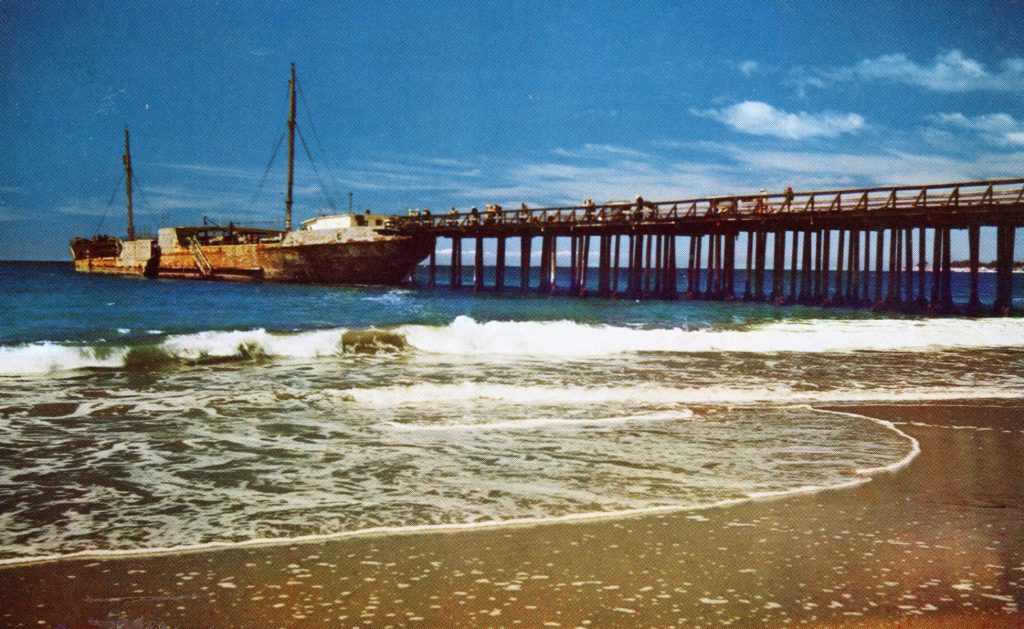Shav LaVigne
The S. S. Palo Alto
Ravaged by the Sea
After surviving 100 years in the Pacific Ocean the fate of the S.S. Palo Alto seems to be sealed!

The Steam Ship Palo Alto began life on May 29, 1919, when she was built by the San Francisco Shipbuilding Company at the U. S. Naval Shipyard in Oakland, California.
Palo Alto and her sister ship, S.S. Peralta, had hulls constructed of reinforced concrete due to the shortage of war time steel. Steel was used to replace war ships lost to German submarines during World War I. This new concrete technology was developed by Norwegian civil engineers Nicolay and Hermann Fougner.
The concrete needed to build the thin reinforced hulls was brought to the construction site from Davenport, California. Davenport is a community north of Santa Cruz which continued to produce concrete until 2010.
The new ship was equipped with a 2,800-horsepower steam engine, a bronze propeller, Norwegian ash decks, and had 14 compartments capable of holding three million gallons of fuel oil.
Unfortunately, Palo Alto was built too late to serve its purpose as a tanker ship during the war. From the time of her launch, she traveled only once, under her own power to Benicia, California, where she was mothballed.
In 1929, Palo Alto was stripped of her engine and propeller and was sold to the Seacliff Amusement Corporation. In 1930, the ship was towed to Seacliff and was purposely grounded.
Soon after her arrival, a 630-foot fishing pier was built to connect with the grounded ship’s stern. Palo Alto saw several renovations designed to have the ship serve as a pleasure destination. A 54- by 154-foot dance floor was added along with a 54-foot heated swimming pool, a café, and carnival type concessions.
In 1930, 3,000 people attended the opening of the ship’s Rainbow Ballroom, which featured big bands like Paul Whiteman’s, Benny Goodman’s, and Tommy Dorsey’s. Gambling was added in the form of slot machines, Bingo, and it is rumored, a full casino was operational below deck.
After only two summer seasons, in 1932 the Seacliff Amusement Corporation went broke due to, among other things, the ongoing depression. To add insult to injury a large ocean storm cracked the Palo Alto’s hull.
Although having an estimated value of $11.2 million, in 1936 the Palo Alto was stripped of all valuables and sold to the state of California for $1.00.
Palo Alto served as a recreational fishing pier until 1950, when it was deemed unsafe for this purpose and closed. Since then she has become an artificial reef for all types of marine life.
In the spring of 2005, oil found on some sea birds was traced to the old ship. Although no oil leaked into the ocean, it was determined that birds came into contact with the oil by entering the ships cracked hull while diving for fish.
In 2006, the state began a massive $1.7 million cleanup. The cost nearly equaled the original 1919 construction costs. Workers pumped 500 gallons of fuel oil from the ship and discovered the remains of many sea birds and a few harbor seals inside.
Since the cleanup, Palo Alto has continued to be battered by Pacific Ocean storms and is in deplorable condition. There has been some discussion of dynamiting the remains of her and removing the wreckage, but as of now, nothing has been done.

The postcards show the ship and pier in happier times when they were being used by fishermen and tourists. Both are pre-1950 chrome postcards.
My dad was a big fan of Benny Goodman, but was born after Palo Alto‘s Rainbow Ballroom hosted dances, and Dad never made it to California before his death earlier this year.